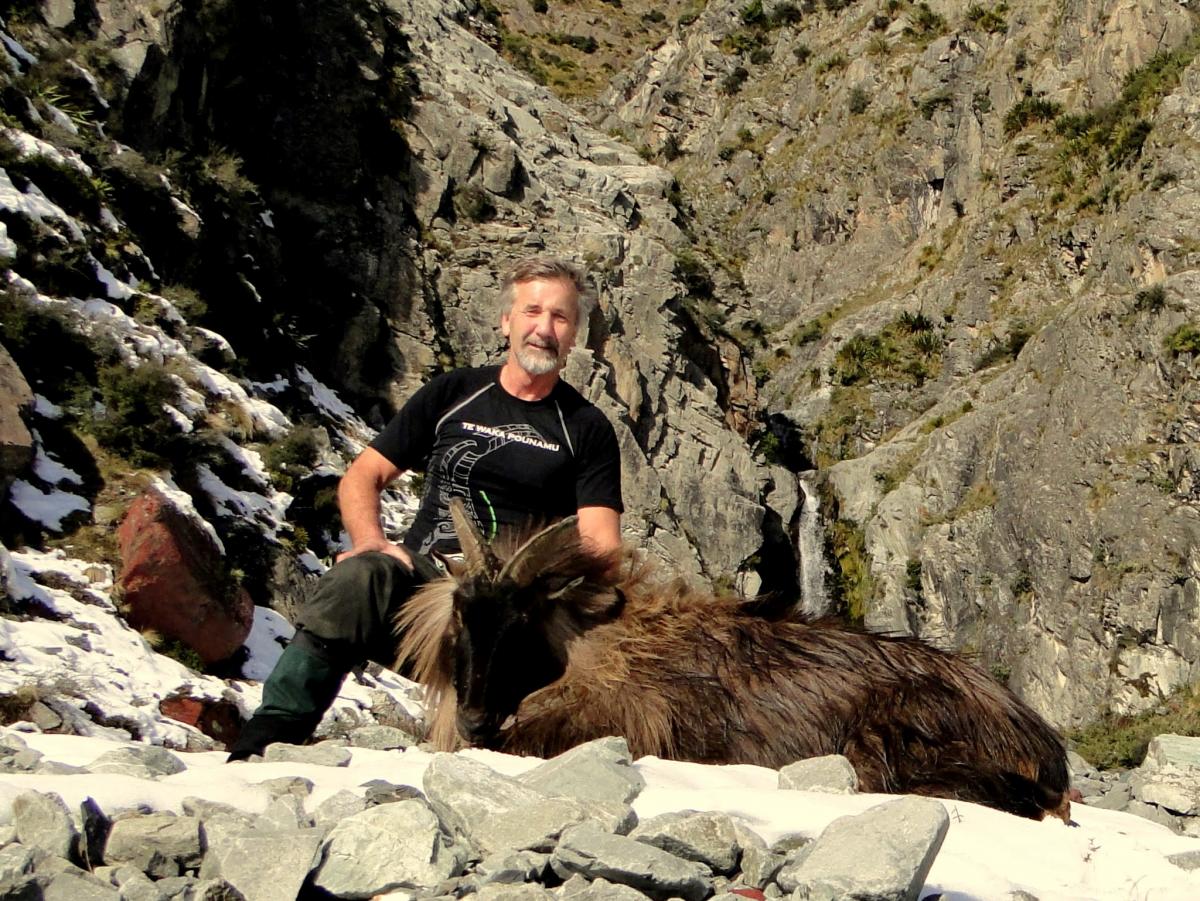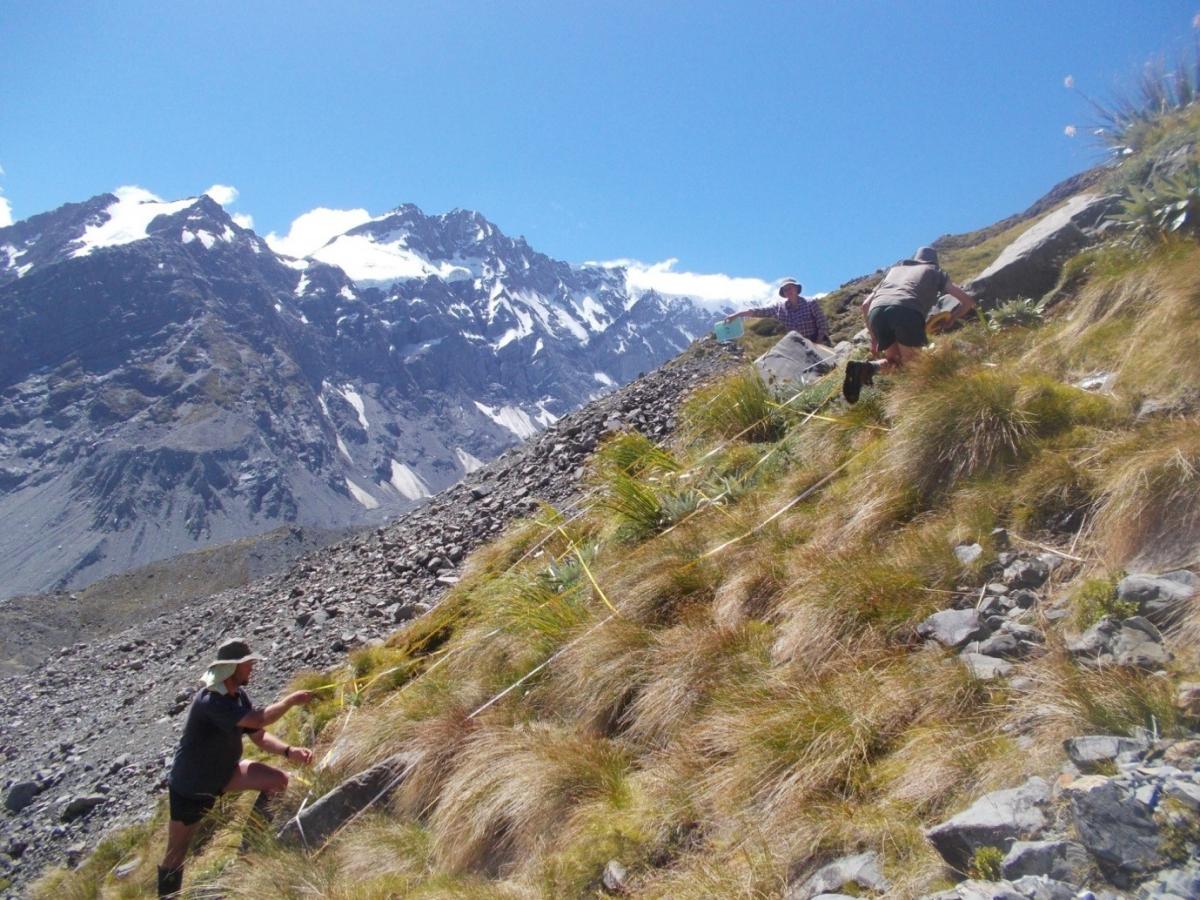Published online: February 2022
Synthesis by: John Parkes; Kurahaupo Consulting, Christchurch, New Zealand

Past Secretary of NZES and regular contributor to the journal, Graham Nugent, doing his bit to control tahr
Thirteen Himalayan tahr/thar (Hemitragus jemlahicus) were introduced to New Zealand via the Duke of Bedford’s estate in Norfolk over two events in 1904 and 1909. Despite these two bottlenecks, tahr were highly successful, reaching a population size of tens of thousands as they spread over the central Southern Alps.
Since 1993, tahr have been managed under a formal plan developed by the Department of Conservation (DOC). The plan evolved after the tahr population decreased, by about an order of magnitude, between 1971 and 1983—following the development of a commercial market for their meat that harvested over 39,000 individuals.
The 1993 plan proposed various management actions. These included limits to the range in which tahr were permitted, the maximum number of individuals for the total population (10,000; perhaps 10% of carrying capacity) and included restrictions on population densities (<1 up to 2.5 thar/km2) based on predicted ecological damage thresholds for the core breeding range. The plan encouraged recreational and commercial meat hunting as a means of harvesting enough individuals to keep the population within the set limits. Official control was only to be implemented where the other harvesters failed to meet the plan’s targets and to limit the spread of tahr outside the existing range. However, by 2018 it was clear that harvesting and DOC’s culling had failed to achieve the intentions of the plan, with the tahr population both increasing its range as well exceeding the 10,000 individual limit. DOC thus initiated new operations to cull tahr, a decision that caused conflict among stakeholders.
Tahr management has always been a hot topic because the views of hunters who want to manage them as a game animal usually conflict with the views of environmentalists who want to manage them as an introduced pest. DOC’s attempt to balance these perspectives was set out in the 1993 plan but that must be justified by data that are robust enough to satisfy the competing stakeholders. This is not straightforward as all data on population sizes, impacts, and harvest numbers have caveats on how it is collected and intrinsic uncertainties that are expensive to resolve.
For example, before the new culling programme, the tahr population was estimated to be 34,478 individuals (95% CL range 26,522 – 44,821). The large variance allowed stakeholders much room to debate intended culling intensity. However, data over the subsequent few years revealed little downward trend in catch-per-unit-effort indices of population sizes, suggesting the populations were recruiting enough to match the losses from culling and/or densities were still high enough to saturate the control method of aerial shooting.
To resolve the core conflict, it is important to quantify the ecological impacts of tahr at given densities. Although it has been suggested that the target densities in the 1993 plan were low enough to allow snow tussocks (the primary food of tahr) to persist in a reasonable state—even at these densities—some impacts were still detected. To effectively resolve some of these conflicts, decisions must be based on robust evidence on the population dynamics of tahr and their impacts to native biodiversity and ecosystems. The solution of managers is to act on the best current estimates, whilst investing in improving the monitoring of tahr populations and their impacts and adapting management actions based on the evidence.

Assessing snow tussock condition on a permanent plot to determine the impact of tahr in the central Southern Alps
Relevant literature:
Cruz, J., Thomson, C., Parkes J.P., Grunner I., Forsyth D.M. (2016). Long-term impacts of an introduced ungulate in a native grassland: Himalayan tahr (Hemitragus jemlahicus) in New Zealand’s Southern Alps. Biological Invasions 19: 339-349. http://doi.org/10.1007/s10530-016-1283-2
Department of Conservation. (1993). Himalayan thar control plan. Canterbury Conservancy Conservation Management Planning Series No. 3. ISSN: 1171-5391
Hughey, K.F.D., Parkes, J.P. (1996). Thar management – planning and consultation under the Wild Animal Control Act. The Royal Society of New Zealand Miscellaneous Series 31: 85-90.
Ramsey, D.S.L., Forsyth, D.M. (2019). Estimates of Himalayan tahr (Hemitragus jemlahicus) abundance in New Zealand. Results from aerial surveys. Arthur Rylah Institute for Environmental Research unpublished client report.
